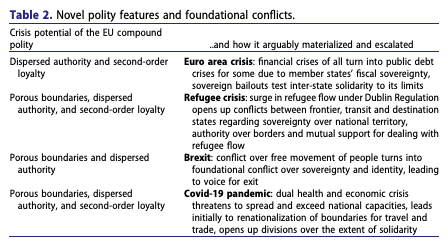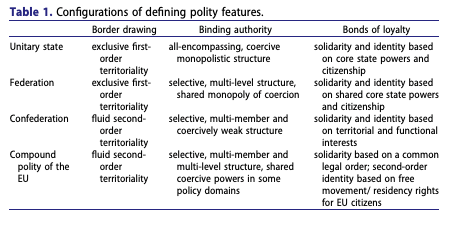Hirschman, Rokkan, and the Three Bs in the EU:
Bounding, Binding, Bonding
The combination of bounding, binding, and bonding (the ‘3Bs’ formula) provides a structure of constraints and opportunities which elicits relatively stable patterns of expectation and behaviour, thus promoting and facilitating constructive social interactions within the polity field.
— Maurizio Ferrera, 2022
Albert O. Hirschman’s ‘Exit, Voice and Loyalty’ is a framework for understanding human responses to institutional decline. The essential argument, that depending on the system that they are dealing with – people can respond to institutional decline either by voicing their discontent or by exiting the arrangement – has been applied at many levels and domains, from family relationships to political dissidents in authoritarian states, to states themselves in international organisations. Crudely and broadly, exit has been understood as an economic imperative, voice a political one, with the bonds of loyalty being an essential determinant of whether one operates using a more economic or political lens..
Stein Rokkan, a contemporary of Hirschman, was a particular enthusiast of this intuitive argument. A political theorist concerned with big structural transformations and processes, Rokkan was concerned with mapping the development of the European state system, and came to integrate Hirschman’s framework into his own model of state building. This produced three related concepts, what the SOLID project labels the Three Bs: bounding, binding and bonding.
These respectively relate to exit, voice and loyalty. Bounding concerns the necessity of constructing an outer border around a bourgeoning polity, a device that both serves to keep outsiders out and, critically, insiders in. Bounding, then, reduces the scope among peoples and states for exit, by demarcating a territory as a distinct, legitimate governing entity. In doing so, it creates a powerful impulse for the development of voice, translated into political institutions that assume a binding authority over the land. Bonding, approximates loyalty, and the levels of social solidarity shared between citizen-members of a polity.
How does all this relate to the EU and its current long decade of crisis politics? The EU is a unique historical attempt at constructing a compound polity, building something that goes further than a club-like international organisation but still falls far short of a federal state, on top of 27 diverse, full-fledged sovereign states already existing in the international system. However, it is still subject to the same essential pressures and incentives that form Rokkan’s state building model.
Table 1 shows the EU’s historical unique arrangement of the Three Bs with respect to other stylised types of polity.
First, SOLID tends to understand the EU as a kind of compound polity. Its bounding arrangement is a form of fluid second-order territoriality. In short, it does not have a cohesive external border to think of, and entry from and exit to the rest of the world remains largely in the hands of member states. If Germany wants to attract investment from China, or if Sweden wants to drive immigration from India, they are basically in control of this. The EU has broken down borders within and between its states for things like the free movement of people and capital, but with the conspicuous exception of free trade, it has generally not constructed an external border comparable to that of a federal or unitary state.
As Rokkan-Hirschman would predict, porous boundaries invariably impact the EU’s binding authority, which is less encompassing than unitary or federal states but goes beyond a regular confederal model. Its authority is dispersed vertically, between states and its (weak) centre; and horizontally, between the institutions at that centre. This varies by policy domain, but in essence the EU binds not with coercive force but ‘legal constriction’, leading critics to question its democratic credentials, especially in times of crisis.
The EU quid-pro-quo of political authority, voice, is underdeveloped in terms of bottom-up individual political participation. Voice channels are selective and do not reach all the way up.
— Maurizio Ferrera, Hanspeter Kriesi, Waltraud Schelkle
Finally, solidarity in the EU’s is based on legalistic privileges and thin bonds of identity between people(s), which data show to be primarily anchored in national identity. Broadly speaking, the process of EU polity building (bordering and binding) has not yet bonded its peoples into a single, coherent political entity but rather a set of individuals who enjoy legal rights and privileges, sometimes enforced by the European Court of Justice. Neither are Europeans sufficiently bonded to actively drive forward the polity building process, which has proceeded most smoothly when Europeans were not paying attention. But is this configuration of the Three Bs static, or might it be shaken and resettled by the major polity crises the EU has been facing over the past 15 years? This is a key question addressed by our research, which aims to interpret outcomes beyond conventional measures of policy integration.
First, in a major statement of the project’s outlook that has guided this summary post, Maurizio Ferrera, Hanspeter Kriesi and Waltraud Schelkle suggest that the EU’s Three Bs present a puzzle: how can an apparently fragile polity beset with destabilising potential by weak bordering, binding and bonding avoid disintegration in a crisis? They summarise three strategies for polity maintenance. Public rhetorical action, from Draghi’s infamous ‘whatever it takes’ speech during the Euro crisis, to Merkel’s public volte face on German fiscal orthodoxy during the Covid crisis, is one key strand. A second is externalisation, which was variably successful in the process of negotiating Brexit and resolving the refugee crisis of 2015-16. During Brexit, the EU’s porous borders and dispersed authority respectively allowed it to show flexibility over the critical issue of bordering the island of Ireland and to create a novel negotiating Task Force that bound the newly-formed EU27 in defence of their key membership privileges. Meanwhile, after Polish and Hungarian defiance over quota settlements, the EU’s externalising of refugee flows to Turkey represents an uneasy

